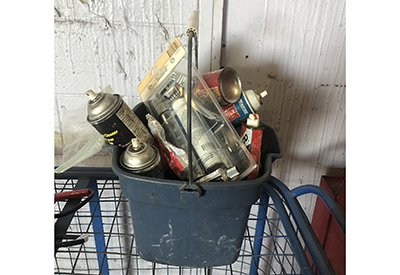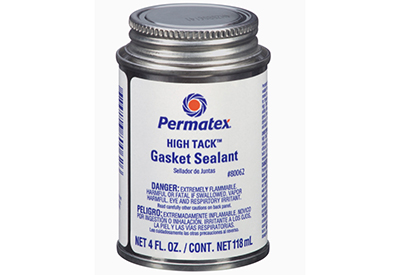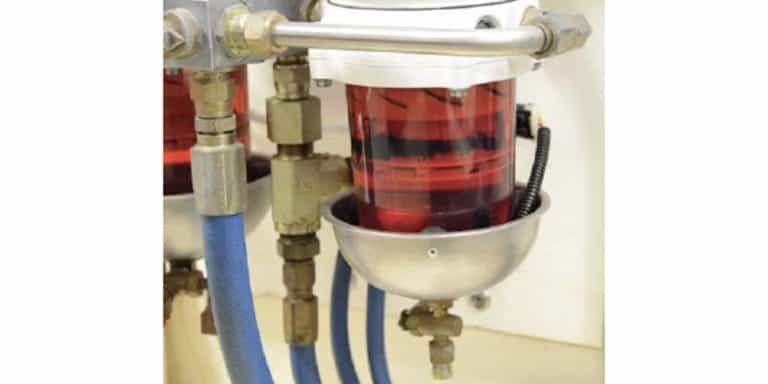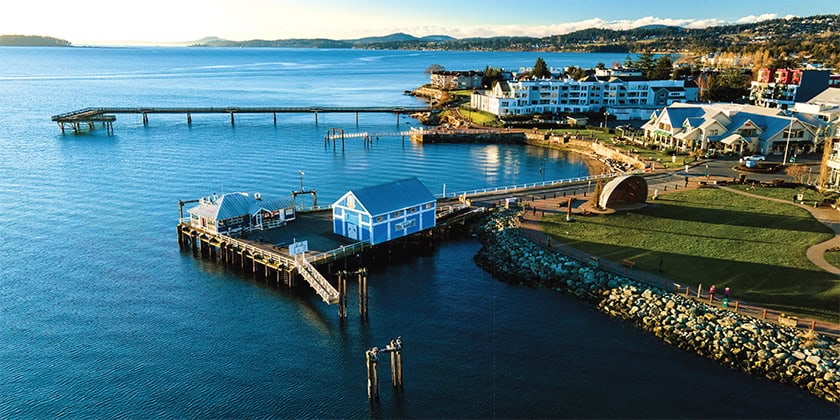Ask Andrew – The Bucket

Aug 27, 2020
I was cleaning up my workbench the other day. My eyes then scanned across my workbench and fell on ‘the bucket’. Everyone has a one. On a boat, it’s usually in a cockpit lazarette. It’s full of old paint cans and half-used tubes of caulking. There might be some white grease, painters tape or epoxy in there, too. I take my bucket everywhere and it’s full of all sorts of tubes of grease and sealants and adhesives. I thought to myself that I should probably sort through the bucket and get rid of the stuff that isn’t useful. I quickly realized, though, that each of the items in my bucket (except that had gone bad) were useful, and each is used for a particular job.
I’d like to tell you what I carry in my bucket (and why it’s there) – and make some suggestions of what you might think to keep in yours:
• engine oil – typically a quart of 10W30. The ‘just in case’ extra oil. On your boat, you may have a quart of gear lube or Transmission or power steering fluid. It all serves the same purpose: The security blanket.
• White grease – This is an all-purpose ‘make it slippery’ sort of grease – great for cable attachments, packing bearings, and other moving parts. If you trailer your boat, you may want to add or substitute trailer bearing grease to ensure that your trailer is well maintained.
• Dry Lubricant – available in a variety of forms, a dry lubricant is a spray lube that dries quickly and wont attract dirt and dust. Great for moving parts in rigging, hinges, rollers, tracks and slides
 a gasket making compound
a gasket making compound
• Gasket maker – every so often, I take apart something that I don’t have a pre-formed gasket for. So I apply a gasket material to create a seal between parts, during re-assembly. VERY handy for on-the-run repairs.
• RTV Sealer – This is a special gasket material used for applications where oil, grease or fuel may come into contact with the gasket, dissolving or penetrating it. For use around oil pans, timing covers and intake manifolds on engines.
• WD40/Mr Wrench – for those ‘all purpose’ jobs – taking out a tough bolt, or just making a part move that isn’t moving well.
• Loctite – The opposite of WD-40 – designed to keep bolts tightly in place, a bit of Loctite is put on bolt threads before installing to keep a tight seal
• 3M 5200 – a caulking material used to create a permanent seal. Originally designed for below-the-waterline applications, it’s become a boating staple. I use it for everything from installing a screw to a transducer. There are other caulking options, from a number of manufacturers, but because 5200 will serve me for all applications, I always keep some in my bucket
• Carb cleaner – removes deposits, gum and varnish from fuel – especially around the fuel fittings and carburetor on an engine.
• Engine degreaser – a great product that removes greasy and oily buildup from surfaces. I will often use this in tandem with cleaning products like Spray Nine: I’ll degrease first, and follow up with the cleaning and disinfectant properties (and nicer smell) of Spray Nine. Great for bilge areas below an engine, and on engine surfaces
• Quicksilver Perfect Seal – Not widely known or used – but a staple in my world. Perfect seal provides a seal between parts (hoses, metal surfaces, bolts, etc) that won’t crack, harden or dry out. The parts can be easily separated when desired, but the seal will stay water-tight. Great for mating surfaces on a stern-drive, or for connecting hoses/clamps with no leaks. Great for thermostat and impeller covers
• Quicksilver Bellows adhesive – think of this as school glue on steroids. It’s meant to be used to aid in connecting and sealing bellows on a stern-drive unit – but I use in often in numerous applications: any time I wish I had a third hand to hold something, or need a quick-acting adhesive. It’s messy, but it works.
• Quicksilver 2-4-C – this is my go-to ahead of white grease or other types of lubricants. It is manufacturer recommended to withstand extreme friction, with a high degree of water resistance. Perfect for lubing impellers when installing, to lubricate shafts, seals and bearings
• Quicksilver Power Tune – this is a carb cleaner, Plus. Designed to clean the entire combustion chamber (and allow the engine to run more efficiently) in both 2 and 4-cycle engines. It’s not a cure-all or a magic fix – but I use it often enough to have a permanent place in my bucket.
 What should you keep in yours? Well – it depends on what projects you plan on tackling, and the products that you’re partial to. I would recommend:
What should you keep in yours? Well – it depends on what projects you plan on tackling, and the products that you’re partial to. I would recommend:
1) A lubricant. Something to aid moving parts to keep moving well. Choose what works best for you, whether it’s a grease or an aerosol, but don’t be afraid to try a new product to see if it works that much more efficiently. Recommendation: Quicksilver’s 2-4-C.
2) A thread sealer. I don’t think we use these often enough. It’s important that bolts, screws and pins don’t move as they vibrate aboard. I would recommend a general purpose loctite
3) Safety blanket items: Engine oil, ATF, Power steering fluid, etc. Things that you’ll need in a pinch to get home if something goes awry on the water.
4) A sealant. I recommend 3M 5200 – so that you can feel secure tackling knowing that any project can be sealed at the highest level.
Buckets that are full of junk will stay junk unless we take the time to consider the why and how of its contents. Buckets that are full of the ‘right’ stuff are tools that support our on-the-water enjoyment.
Andrew McDonald is the owner of Lakeside Marine Services – a boat repair/maintenance firm based in Toronto. Andrew has worked in the marine industry for 12 years and is a graduate of the Georgian College ‘Mechanical Techniques – Marine Engine Mechanic’ program.
 Questions or comments for Andrew? Email him directly via: askandrew@lakesidemarineservices.ca
Questions or comments for Andrew? Email him directly via: askandrew@lakesidemarineservices.ca





























